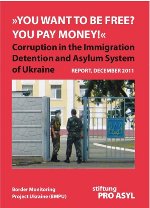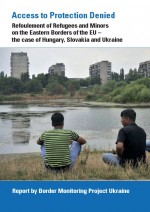The fact that in 2005 the Frontex Headquarters opened in Warsaw, may certainly be considered as a writing on the wall. In the EU “illegal immigration” from and via the east was and still is considered as the main challenge to be met by Migration Control.
The eastern route and the IOM
In the early nineties at the latest the Ukraine caught the eye of the so-called risk analysts, not merely as an emigration country but also as an essential passage for the “eastern human trafficking route”. The country was not an EU-candidate and therefore – contrary to its western neighbouring states Poland, Slovakia, Hungary and Rumania – also not under the obligation to adopt the so-called Schengen Standards. Against this background the IOM (1) at first played the executive part in “outposting” the EU Migration Regime to the most important transit migration country in the east. As early as 1998 an IOM team of experts met with high-ranking Ukrainian government officials in Kiev to start up a “Migration Management Program“. At several levels it was directed against transit migration: the registration and documentation of refugees and immigrants, the set-up of a first deportation camp in Pawschino (2), training courses for the Ukrainian border guards at the US-Mexican border and equipment of a pilot project in Kharkiv (at the Russian border) with radio and infrared technology. “In the course of their work the IOM specialists were confronted with a – for them surprising – problem: they found that more than 70% of the transit migrants entered the Ukraine legally. The government was therefore offered help in introducing new laws and visa regulations. Thus immigration into the Ukraine was first criminalized under the direction of the IOM, in order to be subsequently fought against with means made available by the IOM” (3).
European Neighbourhood Policy (ENP)
The IOM is active in the Ukraine up to this day, in 2008 in particular by setting up the deportation prison in Zhuravychi/Volyn, a brand-new clink equipped according to EU standards and financed with EU means. But the responsibility for the preparation of this “perfect buffer state” has meanwhile been taken over by EU authorities and institutions. The aforementioned clink is part of a comprehensive asylum and migration program, which is being installed since 2004 within the scope of the so-called “European Neighbourhood Policy“ (ENP). ENP was developed in 2004, with the objective of “avoiding the emergence of new dividing lines between the enlarged EU and our neighbours and instead strengthening the prosperity, stability and security of all concerned”, the European Commission euphemistically formulates it. For indeed “an individual plan is made for each EU-neighbouring state, the plan always implying migration-specific regulations as well. A concrete perspective of accession is not offered, but in reward cooperative states can expect visa and trade facilitations as well as special support programs, for which the EU demands on the one hand efficient guarding of the borders and on the other effective readmission treaties. For the Ukraine the ENP-Program for 2007-2010 made available an aggregate support amount of 494 million euro, 30 million euro of which are for the establishment of another five internment camps for immigrants in the context of Readmission-related Assistance”(4). And in the so-called GDISC Ukraine Project (5) several EU states assume functionally-differentiated “sponsorships”. Thus Hungary will assist the Ukraine in setting up eight so-called “screening centres” having the function of selecting between “people in need of protection” and “illegal migrants”, which centres are not to be established at the European external borders, but rather at the eastern borders with Russia. They will serve on the one hand to hold so-called “initial interviews” and will on the other hand provide internment facilities for up to ten days. Further areas of the GDISC Project are: support of Polish authorities for the implementation of asylum procedures, information about countries of origin by Slovakia, passing on of “best-practice” experiences with returns by the UK, expansion of the visa regime by the Netherlands, as well as the long-term internment of “illegal migrants“ by liaison officers of the Czech Republic (4).
Frontex Five Borders
Finally, this Europe-wide “division of labour“ is completed by the supplementary activities of the EU border patrol agency. For the Ukraine 11 June 2007 ought to be written in the history books as the day the starting shot was given for the Frontex-era. On this day, still under German EU presidency, a first treaty between Frontex and the Ukraine was negotiated and finalized in Luxemburg. Schäuble was the chairman and present were Frattini (6) and on behalf of the Ukraine the Ministers of Home Affairs and of Justice. “Tackling illegal migration and organized crime invariably requires a joint response” Schäuble allegedly said in this meeting. And the arrangements made in view of “the strengthening of border security by intensifying border patrols as well as the exchange of information“ obviously constituted the basis for a first Frontex operation that started shortly thereafter under the name “Five Borders” and for the first time involved Ukrainian border guards. This pilot project, which ran from July until December 2007 (7), was divided into four sub-projects which, as Ursus I to IV, aimed at improving the cooperation of the border patrols at the Slovakian, Polish, Rumanian and Hungarian borders to the Ukraine. With a total of 350,000 Euro the budget of the operations was still relatively small. The “yield” – approx. 100 run-in “illegal migrants“ in the border area and 250 entry refusals (8) – also seems rather symbolic. But Frontex was obviously less concerned about efficiency, than about for the first time involving the Ukrainian border authorities in guarding the external borders of the EU in the east. The Frontex operations for 2009, named Jupiter, are also focusing on the Slovakian-Ukrainian border because there “the pressure of illegal migration is continuously high”.
Readmission Treaty and Refoulement
Finally I will comment on the perhaps most important treaty, which in the years to come might turn the Ukraine, in the literal sense of the word, into a hot spot. What was set on foot with the ENP procedures as well as at the Frontex meeting in Luxemburg, came into force in its first step in January 2008: the Readmission Treaty between the EU and the Ukraine. This first step concerns the “readmission“ of Ukrainian citizens who are picked up in EU States and should be deported more quickly. The second and decisive step will, as from January 2010, also involve third-country nationals, that is refugees and immigrants who pass through the Ukraine on their way to the EU. The Ukraine will not only be totally overloaded in terms of infrastructure with thousands of additional returns, but the mentioned efforts in the context of the ENP Program and in particular the Readmission Treaty rather show the strategic purpose of the EU: to certify as soon as possible that the Ukraine is a safe third-country. For in spite of new treaties the EU border guards are actually under the obligation to differentiate between “illegal migrants” and asylum-seeking refugees. As long as the Ukraine is not a safe third-country, the latter may theoretically not be send back. But as early as 2006 the UNHCR reported about unlawful returns of Chechen refugees from Slovakia to the Ukraine. And border-monitoring initiatives in Hungary and in Western-Ukraine again found in the early summer of 2009 that Somalian and Afghan refugees were regularly denied access to asylum procedures. Rounded up in the Hungarian border region, the persons concerned are turned over to the Ukrainian border guards, who intern them up to six months in the wretched and crammed full deportation camp of Chop (9). In the same way as put into practice in the Mediterranean by Greek and Italian border guards (who are at least covered if not supported by Frontex!), the Non-Refoulement prohibition is also systematically violated at the eastern external borders. The Geneva Convention is virtually rendered inoperative in this hot spot as well. The comprehensive efforts of the EU to enable by all means the certification of the Ukraine as a safe third-country appears in this respect as an attempt to legalize, at least for the future, the continuous practice of illegal returns.
h., kein mensch ist illegal/Hanau
(1) IOM: International Organisation of Migration, pioneer on the subject of global migration management, see
http://www.noborder.org/iom/index.php
(2) The internment camp in Pawschino in Transcarpathia was set up and operated by the IOM at the end of the nineties, a militarized starvation camp that was increasingly criticized and was closed down in December 2008 also due to international public opinion and protest actions, see
http://pawschino.antira.info/
(3) quoted from an Ukraine text in the brochure „Stop the IOM – Global Movement against Migration Control“, published by the Antirassismus-Büro Bremen in 2004.
(4) quoted from a text by Marc Speer: „The Ukraine as a country used for transit migration“ 2009.
(5) GDISC: the General Directors’ of Immigration Services Conference was founded in Rotterdam in 2004 as an EU Network for Adjustment Programs. “Capacity Building and Technical Support to Ukrainian authorities to Effectively Respond to Irregular Transit-Migration (ERIT) – A comprehensive and complementary approach to migration management support in Ukraine” is the full title of the program, which is moreover being realized under the authority of the Viennese ICMPD. Obviously nearly all the important migration management agencies want(ed) to be involved in the Ukraine.
(6) Frattini: at the time still the EU Commissioner for Justice and Home Affairs and with Schäuble the initiator of the so-called Future Group, before he returned in 2008 under Berlusconi as Minister of Foreign Affairs to the more and more openly racist, Italian national politics.
(7) “Pilot projects are implemented in order to develop new methods and elements in border guarding …“ – see text concerning the Frontex operations in the brochure.
(8) according to Frontex’ own data of 2008.
(9) Chop: Ukrainian town bordering on Hungary; the intolerable conditions in the deportation prison in that town have already been described in detail in 2007, see
http://pawschino.antira.info/



